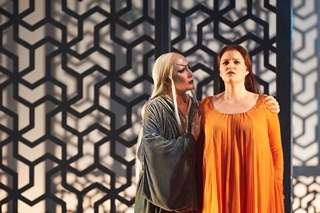|
Back
Opera from the 21st Century Toronto
The Four Seasons Centre for the Performing Arts
02/02/2012 - & February 4, 8, 10, 12, 14, 18, 22, 2012
Kaija Saariaho: L’Amour de loin
Russell Braun (Jaufré Rudel), Krisztina Szabo (The Pilgrim), Erin Wall (Clémence)
The Canadian Opera Company Chorus, Sandra Horst (Chorus Master), The Canadian Opera Company Orchestra, Johannes Dubus (Conductor)
Daniele Finzi Pasca (Production, Lighting Design), Julie Hamelin (Creative Associate), Gabriel Finzi Pasca (Associate Director), Jean Rabasse (Set Design), Kevin Pollard (Costume Design), Alexis Bowles (Lighting Design)

K. Szabo, E. Wall (© Michael Cooper)
Not much happens in L’Amour de loin, but it happens (or doesn’t happen) very beautifully in this production currently playing in Toronto and earlier (review in French) in Belgium (Vlaamse Opera), and the UK (ENO).
The story: Jaufré Rudel, a princely troubadour in Aquitaine, is told of a beautiful woman, the Countess Clémence, in far-off Tripoli. He falls in love with the very idea of her and composes ardent love songs. An unnamed pilgrim travels there and tells Clémence about his devotion. The pilgrim returns to France and Jaufré is certain that the pilgrim was unable to do justice to his songs. He resolves to travel to Tripoli. Tormented by doubts on the voyage, he falls ill and dies right after the two “lovers” meet. Clémence, who earlier had wondered whether she is worthy to be an ideal object of distant love, transmogrifies the experience into something religious.
The tale is from the courtly love tradition, wherein the object of love remains idealized and out-of-reach. Consummation would only sully the purity of the emotions expressed.
Kaija Saariaho’s music is scintillating and colourful, making discreet use of a synthesizer plus augmented woodwind and percussion sections. It doesn’t have much forward motion in it, which suits the contemplative nature of the libretto. The rich tonality reminds me of a 19th century opera based on a similarly exotic subject, namely Massenet’s Escalmonde. However, if the work challenges audience members (and there are a number of empty seats after the intermission) it is more likely due to the lack of dramatic action, not the musical idiom.
The directing team (brothers Daniele and Gabriele Finzi Pasca and Julie Hamelin) come from Quebec’s vibrant circus milieu (specifically the Cirque Éloize). Therefore we get acrobats, with each of the lead roles represented by three performers, one singer and two acrobats who swoop through the air at significant moments, or do cartwheels, whirling dervish movements, etc. There is also shadow puppetry. The busy-ness of the production creates a suspicion that it is attempting to dress up a thin narrative line.
The vocal parts are gratefully singable, even without memorable melody. Erin Wall as Clémence displays an absolutely glamorous voice (happily she returns to the COC soon in Les Contes d’Hoffmann). Company stalwart Russell Braun gives full ardour to his role. As the Pilgrim/messenger, Krisztina Szabo, done up much like a mad figure from Kabuki drama, has to start off with spoken lines which don’t project all that well. All is fine when she gets to sing, although the part does not allow her to develop the character. At the end she joins in the thoughts expressed by Clémence, which is dramatically confounding but creates lovely sounds.
More dramatic use might have been made of the chorus which is offstage until the final scene (thus leaving the stage free for the acrobats).
The design gives us many striking images, notably during the sea voyage.
While the two lovers are historical figures of the 12th century, there is no attempt to compose music that echoes the era. Similarly, with respect to the plot, there is no attempt to tie it in with historical events, such as the crusades (Jaufré Rudel died in Tripoli after participating in the 2nd crusade, and legend has it that he died in the arms of a noble lady there). Nor do sets and costumes have an historicist flavour, although Clémence initially appears in a rather Byzantine garment, later replaced by a flowing, modern-looking gown.
There is one jarring anachronism in the surtitles: the modern word “gurney” is used to describe the litter upon which the dying Jaufré is carried from the ship.
The whole experience is akin to being in that wonderful darkened room in Paris’s Museé de Cluny where one just sits and marvels at the Unicorn Tapestries. (It turns out that Saariaho has
composed a clarinet concerto based on the six tapestries). One cannot expect drama in the usual sense, but instead a contemplation of beautiful images with a meaning that floats in and out of focus. So it is with this opera. Thanks to the time demands of music one must spend two hours or so in contemplation, not everyone’s idea of an exciting evening out. Still, it has its rewards.
And, by the way, this is the first time the Canadian Opera Company has presented an opera composed by a woman. Operas composed by women are not exactly plentiful (in 48 years of opera going I have now seen five), but Kaija Saariaho is doing her bit to make up for this: with her librettist for this work, Amin Maalouf, she has now composed four.
Michael Johnson
|